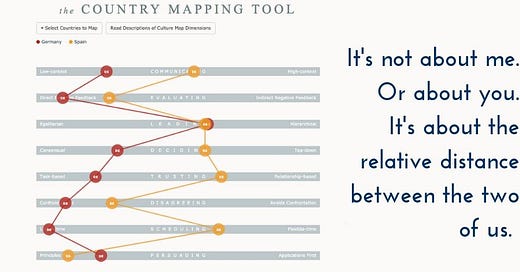Leading across cultures - remotely
Acknowledging subtle (and not so subtle) differences can make all the difference
This presentation and recording dates back to 2019 when I had just discovered the Culture Map by Erin Meyers. The book continues to be my most read and recommended book for anyone who works with intercultural teams, and every time I run a workshop on the content, I learn something new. Here’s the original entry from July 8, 2019, followed by some updated thoughts on intercultural remote-ness.
On a recent leadership retreat (2019) for Support Team leads at Automattic, I presented a framework to understand cultural differences among team members. Focussing on the characteristics of business culture in different countries, this framework helps to understand why miscommunication can happen. The presentation heavily relies on the work of Erin Meyer, and I absolutely recommend her book The Culture Map on that matter.
In a nutshell – the question is not whether Germans are direct per se. Instead, the question is whether Germans express negative feedback more or less direct than your own business culture. Depending on whether you are American or Dutch, the answer will vary.
These are the eight different dimensions you can map business culture on:
Continuum from low-context to high-context communication
Continuum from direct to indirect negative feedback when evaluating other people
Continuum from egalitarian to hierarchal leadership
Continuum from consensual to top-down decision making
Continuum from task-based to relationship-based trust
Continuum between confrontational or harmony-seeking disagreement styles
Continuum between linear of flexible understanding of time
We did not record the session at the time for privacy reasons. However, I did a second, less example ridden presentation this week. Enjoy:
And here are the slides: Presentation: Leading Across Cultures
Six years later, and the world has changed - substantially so. Distributed and diverse teams are more ubiquitous. The increased number of (unorganized) hybrid organizations have moved even team meetings to video calls, disconnecting colleagues without a mitigation strategy in place. (Yes, I HAVE THOUGHTS ABOUT THAT - but for a different day!)
So how do you address cultural differences when colleagues hardly know who’s based in which country, nevermind who has which cultural background? How do you account for majority culture, when the minorities are invisible behind avatars and camera-off meetings? And why should you care?
Company culture is what your employees do every day. If this includes demonizing people they’ve never seen in person or dismissing those whose desk is not in the same physical space, then you’ve successfully created a silo culture. Trust and collaboration are the first to die in this environment. And so is the awareness that other may think different to yourself.
One of the biggest changed I’ve observed running culture map inspired workshops over the past years is the decreased awareness of differences. When sitting in an office with people who are like you, it’s easy to forget that those who are in a different office (in a different country) may think and communicate differently - not because they are stupid, but because they were socialized differently.
And that’s exactly why you need in-person company retreats that bring together people from different locations. This is not about the joy of traveling, this is about the need to connect and recognize the differences that make collaboration difficult. Because once you see these differences, they make collaboration possible.
So here’s your to do for today:
Read the book “The Culture Map” by Erin Meyer and critically ask yourself what htis means for YOUR business. Or get in touch and book a workshop with me and I can walk you and your team through culture as an asset, not a problem.
Get your team(s) together, in person. It’s not rocket science, and it will transform the way you work together.
Happy full moon!



